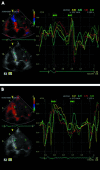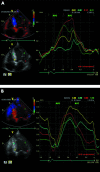Tissue Doppler velocity is superior to displacement and strain mapping in predicting left ventricular reverse remodelling response after cardiac resynchronisation therapy
- PMID: 16621873
- PMCID: PMC1861066
- DOI: 10.1136/hrt.2005.083592
Tissue Doppler velocity is superior to displacement and strain mapping in predicting left ventricular reverse remodelling response after cardiac resynchronisation therapy
Abstract
Objective: To compare the values of three different forms of tissue Doppler imaging (TDI) processing in predicting left ventricular (LV) reverse remodelling-namely, tissue velocity, displacement and strain mapping.
Design: Standard echocardiography with TDI was performed before and 3 months after cardiac resynchronisation therapy (CRT).
Setting: University teaching hospital.
Patients: 55 patients with heart failure who received CRT and were followed up for at least 3 months were recruited.
Interventions: During off-line analysis, the time to peak systolic velocity in the ejection phase, time to peak positive displacement and time to peak negative strain were measured in the six basal, six mid-segmental model. Parameters of systolic asynchrony derived by velocity, displacement and strain mapping were correlated with percentage reduction in LV end systolic volume (LVESV) and absolute gain in ejection fraction (EF).
Results: Among the three TDI processing technologies, all parameters of tissue velocity correlated with LV reverse remodelling (r = -0.49 to r = -0.76, all p < 0.001), but the predictive value was strongest in models with 12 LV segments. For displacement mapping, only the two parameters that included 12 LV segments correlated modestly with reduction in LVESV (r = -0.36, p < 0.05) and gain in EF. However, none of the strain mapping parameters predicted a favourable echocardiographic response. The receiver operating characteristic (ROC) curve areas were higher for parameters of tissue velocity based on 12 LV segments (ROC areas 0.88 and 0.94) than the corresponding areas derived from displacement mapping (ROC areas 0.72 and 0.71).
Conclusion: Tissue velocity parameters of systolic asynchrony are superior to those of displacement and strain mapping in predicting LV reverse remodelling response after CRT.
Similar articles
-
Usefulness of tissue Doppler velocity and strain dyssynchrony for predicting left ventricular reverse remodeling response after cardiac resynchronization therapy.Am J Cardiol. 2007 Oct 15;100(8):1263-70. doi: 10.1016/j.amjcard.2007.05.060. Epub 2007 Aug 20. Am J Cardiol. 2007. PMID: 17920368
-
Triplane tissue Doppler imaging: a novel three-dimensional imaging modality that predicts reverse left ventricular remodelling after cardiac resynchronisation therapy.Heart. 2008 Mar;94(3):e9. doi: 10.1136/hrt.2007.122564. Epub 2007 Nov 5. Heart. 2008. PMID: 17984218
-
A novel tool to assess systolic asynchrony and identify responders of cardiac resynchronization therapy by tissue synchronization imaging.J Am Coll Cardiol. 2005 Mar 1;45(5):677-84. doi: 10.1016/j.jacc.2004.12.003. J Am Coll Cardiol. 2005. PMID: 15734610
-
Clinical aspects of left ventricular diastolic function assessed by Doppler echocardiography following acute myocardial infarction.Dan Med Bull. 2001 Nov;48(4):199-210. Dan Med Bull. 2001. PMID: 11767125 Review.
-
Reverse remodelling in heart failure with cardiac resynchronisation therapy.Heart. 2007 Feb;93(2):167-71. doi: 10.1136/hrt.2005.067967. Epub 2006 Apr 27. Heart. 2007. PMID: 16644861 Free PMC article. Review.
Cited by
-
Acute and chronic response to CRT in narrow QRS patients.J Cardiovasc Transl Res. 2012 Apr;5(2):232-41. doi: 10.1007/s12265-011-9338-3. Epub 2011 Dec 30. J Cardiovasc Transl Res. 2012. PMID: 22207279 Clinical Trial.
-
SPECT myocardial perfusion imaging for the assessment of left ventricular mechanical dyssynchrony.J Nucl Cardiol. 2011 Aug;18(4):685-94. doi: 10.1007/s12350-011-9392-x. J Nucl Cardiol. 2011. PMID: 21567281 Free PMC article. Review.
-
Striving towards the ideal cardiac functional assessment strategy: the contribution of tissue Doppler, strain and strain rate imaging.Cardiovasc J Afr. 2007 Nov-Dec;18(6):387-92. Cardiovasc J Afr. 2007. PMID: 18092117 Free PMC article. Review.
-
Echocardiographic assessment of ventricular dyssynchrony.Curr Heart Fail Rep. 2008 Mar;5(1):31-7. doi: 10.1007/s11897-008-0006-0. Curr Heart Fail Rep. 2008. PMID: 18460292 Review.
-
Cardiac resynchronization in 2008: an echo approach.Curr Cardiol Rep. 2008 May;10(3):211-7. doi: 10.1007/s11886-008-0036-y. Curr Cardiol Rep. 2008. PMID: 18489865 Review.
References
Publication types
MeSH terms
LinkOut - more resources
Full Text Sources
Medical
Research Materials




